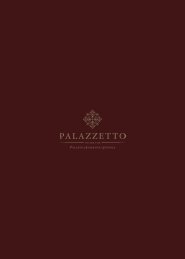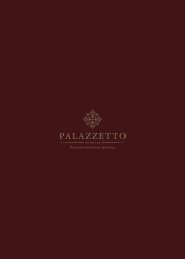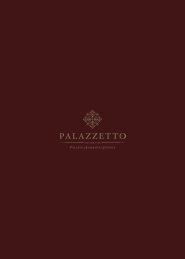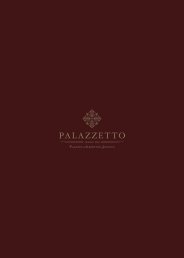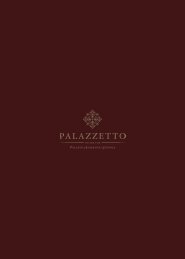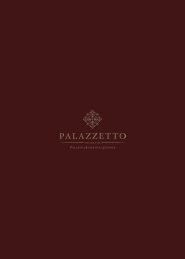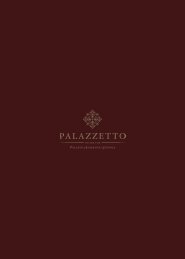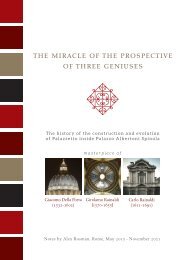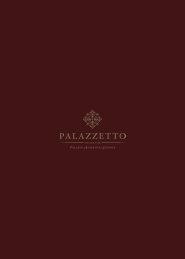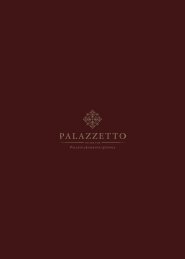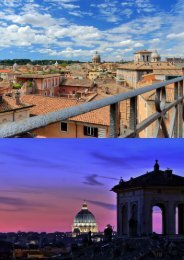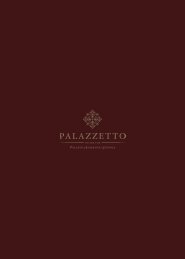Palazzetto_Book_LivingInside (1)
Create successful ePaper yourself
Turn your PDF publications into a flip-book with our unique Google optimized e-Paper software.
-1 -
chapter i • introduction •<br />
-2 -<br />
- 3 -
By<br />
Giacomo Della Porta (1533 - 1602)
“Ciò che era accaduto nella grande epoca<br />
della Penisola Ellenica accadde di nuovo<br />
nell’Italia del Rinascimento. La liberazione<br />
dalle catene rese gli individui energici e<br />
creativi, producendo una rara fioritura di geni’’<br />
- Bertand Russell
view of palazzetto designed by giacomo della porta, from piazza capizucchi view of st. peter’s dome (finished by giacomo della porta) from the interior
I<br />
introduction<br />
chapter i • introduction •
introduction<br />
chapter i • introduction •<br />
Rome:<br />
The World’s<br />
Great Beauty<br />
History, Culture, Human Genius and beautiful landscape have<br />
united to make Rome one of the important cities in the world.<br />
Founded around 753 BC, it was the center and the most powerful<br />
city of Western Civilization, ruling all the Mediterranean, Northern<br />
Africa, England and parts of the Middle East. It became a worldwide<br />
center of pilgrimage, and later in the Renaissance, as the city became<br />
a major European capital of the arts, education, philosophy and<br />
trade, it became an important crossroads for bankers, artists and<br />
philosophers.<br />
Rome, the Eternal City, today is one of the most important<br />
tourist destinations of the world, due to the vast concentration of<br />
archaeological and art treasures as-well-as the charms of unique<br />
traditions, the beautiful panoramic views and the grandeur of the<br />
magnificent “villas” (parks). Nestled around the City’s significant<br />
resources are plenty of museums, aqueducts, fountains, churches,<br />
palaces, historical buildings, the monuments and ruins of the Roman<br />
Forum, and the Catacombs.
view of rome from the rooftop terrace looking towards st. peter’s basilica
introduction<br />
chapter i • introduction •<br />
Rione Campitelli:<br />
The Neighborhood<br />
The <strong>Palazzetto</strong> of the Palazzo Albertoni Spinola is located in Rome,<br />
in the historic Rione Campitelli. The small and prestigious size of the<br />
area and, above all, its richness of prominent archaeological sites<br />
and museums, make it one of most desired places to live in Rome.<br />
The coat of arms of the district bears a black head of a dragon against<br />
a white background. The coat of arms is believed to go back to a<br />
medieval legend of an evil monster which in the fourth century was<br />
a threat to the Roman Forum until it was driven out through the<br />
intervention of Pope Sylvester I.<br />
The origin of the name of the district Campitelli, according to local<br />
belief, comes from Capitolium Hill, the highest of the Seven Hills<br />
of Rome which on top of there stood the most important ancient<br />
roman temple (dedicated to the worship of the triad of Jupiter, Juno<br />
and Minerva).<br />
Within this district is the piazza del Campidoglio (Capitolium) which<br />
is still considered, as it was two millennia ago, to be the geographical<br />
center of Rome, the reference point to count all road distances with<br />
respect to the city.<br />
Additionally, the District of Campitelli, and specifically the<br />
<strong>Palazzetto</strong>, are centrally located between the Coliseum, the Vatican<br />
City, the Spanish Steps, the Tiber River and other significant<br />
historical monuments and locations.
image of the neighborhood neighborhood
II<br />
location map
the view of the altar of fatherland from the rooftop terrace of the palazzetto
2<br />
Vatican - 15 minutes<br />
28<br />
13<br />
19<br />
27<br />
18<br />
4<br />
26<br />
22<br />
17<br />
10<br />
3<br />
20<br />
23<br />
12<br />
11<br />
21<br />
25<br />
9<br />
15<br />
5<br />
14<br />
6<br />
16<br />
24
1<br />
8<br />
7<br />
points of interest<br />
<strong>Palazzetto</strong><br />
1. Colosseum<br />
2. Vatican City<br />
3. Theater of Marcellus<br />
4. Pantheon<br />
5. Eliseo Theater<br />
6. Palatine Museum<br />
7. Brancaccio Theater<br />
8. The Basilica of St. Sylvester<br />
9. Trajan’s Forum<br />
10. Square of Gesú<br />
11. Circus Maximus<br />
12. Altar of the Fatherland<br />
13. Navona Square<br />
14. Baths of Septimius Severus<br />
15. Farnese Gardens<br />
16. Arch of Constantine<br />
17. The Turtle Fountain<br />
18. Theater Argentina<br />
19. Museum of Rome<br />
20. Gloria Pamphilj Gallery<br />
21. Roman Forum<br />
22. St. Mary above Minerva<br />
23. Venezia Square<br />
24. Arch of Titus<br />
25. St. Andrew of Quirinal<br />
26. St. Cecilia in Trastevere<br />
27. Ministry of Cultural Heritage<br />
28. Basilica of St.Mary in Trastevere
III<br />
palazzo albertoni spinola: a history
Palazzo, making this unit a unique property of its kind.<br />
C)the use of the old roof secret garden of the <strong>Palazzetto</strong> from the first floor of the<br />
connection between the square and the inner courtyard;<br />
countess Marina Baldeschi (1895-1983)].<br />
pre-existed building. In fact, the entrance gallery of the building forms a diagonal<br />
Mario Cingolani (1883- 1971), while Bonifacio Spinola married his second cousin,<br />
original door of the <strong>Palazzetto</strong>, despite having built the great Palazzo in front of what<br />
Bonifacio. Maria Antonietta Spinola was later to marry the well-known politician<br />
the Campitelli Church located in front of the Palazzo Albertoni Spinola) from the<br />
Palace to her direct descendants, Genoese Marquis Spinola, Maria Antonietta and<br />
B) the preservation of direct view of the entry of Santa Maria (which is<br />
Carolina Portalupi (1852-1891) who restored it. Subsequently, the Countess left the<br />
Palazzo;<br />
Thereafter, in 1886, the building was sold by the descendants of Pacca to Countess<br />
without being able to recognize that you are in one side or in the other part of the<br />
A)the architectural integration of the new construction into the ancient preexisting<br />
<strong>Palazzetto</strong>, allowing this unit to extend and merge into the new construction<br />
death, caused:<br />
and 1580. Partcularly the project, that archiect Rainaldi finished after Della Porta<br />
structures and the internal partitions of the big building, in the years between 1560<br />
The work of Della Porta involved the project and the construction of the bearing<br />
the buildings De Rossi (later Cavalletti) and Capizucchi.<br />
history<br />
Albertoni to Giacomo della Porta (ca. 1540-1602), in an area likely to be rebuilt between<br />
interventions in late 1616. The work was commissioned by Marquis Baldassarre Paluzzi<br />
Campitelli, was built between 1603, and the years immediately following, with some<br />
in the 10th District of Rione Campitelli. The facade of the Palace, facing the piazza<br />
The Albertoni Spinola Palace, with an entrance in Campitelli square at n. 2, is located<br />
history<br />
including cardinals Giacomo Piccolomini and Giacomo Antonelli.<br />
fifty years with his grandchildren who rented parts of it out to their acquaintances<br />
there from time to time at least from 1819. After Pacca’s death, the Palace remained for<br />
later, the building was handed over to Cardinal Bartolomeo Pacca (1756-1844) who lived<br />
Alvares de Faria Ríos Sánchez Zarzosa, prince of Paz de Basano (1767-1851). Somewhat<br />
around 1808 by Prince Paluzzo Altieri to a famous Spanish general, Manuel Godoy y<br />
more than a century, was elevated with a fourth floor on top of the attic, and was sold<br />
The Palace, which remained in the hands of the offspring of the Altieri Family for<br />
building, at the height of the first floor).<br />
restructuring at that time (this is the archway built in the back, in the outside of the<br />
archway to allow passage to his “nearest neighbors” who were carrying out further<br />
Palazzo<br />
Albertoni Spinola<br />
additional permit to construct, over the back door of his palace and over the alley, an<br />
the new wall with the corner of the adjacent Capizucchi palace. In 1616 he required an<br />
new facade, widening the area of the existing property towards the square and aligning<br />
In fact, in 1603 Knight Baldassarre Paluzzi Albertoni requested a permit to build the<br />
chapter ii • palazzo albertoni spinola: a history • chapter ii • palazzo albertoni spinola: a history •
IV<br />
ancestors, saints & heroes
tomb of pope benedict xv at st. peter’s basilica<br />
members connections within the Vatican.<br />
ambassadors, saints, heroes and literary persons with family<br />
The Spinolas distinguished themselves as soldiers, prelates,<br />
ancestors<br />
12th century.<br />
furnished many consuls to the aristocratic “consular” commune of<br />
families, that dominated the history of Genoa, Italy, during the citystate’s<br />
great period, from the 12th to the 14th century. The Spinolas<br />
Spinola family is one of the most ancient and important Genoese<br />
ancestors<br />
Spinola Family<br />
chapter vii • ownership • chapter vii • ownership •
Matilde of Canossa (1046 – 24 july<br />
1115), was a powerful feudal lady<br />
in northern Italy and the chief<br />
Italian supporter of Pope Gregory VII<br />
during the investiture controversy.<br />
In addition, she was one of the few<br />
medieval women to be remembered<br />
for her military accomplishments,<br />
which allowed her dominion over all<br />
the territories north of the church states.<br />
Gianluca Spinola was an Italian<br />
partisan, descended from a noble<br />
family of Genoa, who was shot by<br />
the Germans at the end of World<br />
War II. He volunteered in the<br />
resistance for the liberation of Italy<br />
and attacked overwhelming German<br />
forces at Castel s. Giminiano. He was<br />
surrounded and taken prisoner on<br />
the 2nd of June, and was killed on the<br />
14th of June 1944.<br />
Matilde di canossa<br />
Gianluca spinola<br />
ancestors<br />
ancestors<br />
Blessed Charles Spinola (1564 – 10<br />
September 1622), also known as Carlo<br />
Spinola, was a Jesuit missionary<br />
from Genoa, martyred in Japan as a<br />
missionary.<br />
Charles spinola<br />
Pope Benedict xv (21 November 1854<br />
– 22 January 1922), born Giacomo<br />
Paolo Giovanni Battista della Chiesa,<br />
cousin of Maria Antonietta Spinola,<br />
was Pope from September 3, 1914<br />
to his death in 1922. His pontificate<br />
was largely overshadowed by World<br />
War I and its political, social, and<br />
humanitarian consequences in Europe.<br />
Pope benedict xv<br />
chapter vii • ownership • chapter vii • ownership •
V<br />
architecture & art
the enjoyment of the <strong>Palazzetto</strong> secret garden even from the new Palazzo first floor.<br />
Church, through the diagonal trend in the new courtyard of Palazzo and third with<br />
view perspective from the entrance of the ancient building to Santa Maria in Campitelli<br />
<strong>Palazzetto</strong> to extend into the new construction seamlessly; second in the creation of<br />
revealed firstly through the integration of the two units that enables the ancient<br />
The genial imprint of Giacomo della Porta on the project of Palazzo Albertoni Spinola is<br />
1588-1590.<br />
in collaboration with Domenico Fontana, completed Michelangelo’s dome between<br />
From 1573 he was in charge of the ongoing construction of St. Peter’s Basilica, and later,<br />
designs.<br />
the mother church of the Jesuit order, and in 1584 modified its façade after his own<br />
After the death of Vignola in 1573, Della Porta continued the construction of il Gesù,<br />
architecture<br />
steps up to the piazza del Campidoglio).<br />
the facade and steps of Palazzo Senatorio, and the Cordonata Capitolina (the ramped<br />
for the rebuilding of the Campidoglio or Capitoline Hill’s open spaces by completing<br />
da Vignola, his teacher of architecture. After 1563 he carried out Michelangelo’s plans<br />
Della Porta was influenced by and collaborated with Michelangelo, and Giacomo Barozzi<br />
Basilica. He was born at Porlezza, Lombardy, and died in Rome.<br />
and sculptors, who worked on many important buildings in Rome including St. Peter’s<br />
Giacomo Della Porta (c. 1533 – 1602) was one of the most important Italian architects<br />
Giacomo Della Porta<br />
The Great Architect<br />
chapter iii • architecture & art •<br />
view of the monumental stairs
example of the palazzetto’s workmanship showing mouldings, metal works, marble floor and hand-crafted door against the monumental stairs
Lion motifs are scattered throughout the property,<br />
and are prominently featured over many doorways and thresholds<br />
Beautiful sculptural mouldings line the ceilings of the palace<br />
with floral and maritime motifs<br />
architecture<br />
architecture<br />
Plaster Lions<br />
Mouldings<br />
chapter iii • architecture & art • chapter iii • architecture & art •
Exquisitely crafted iron and bronze works can be found<br />
everywhere inside and outside the property<br />
Glass mosaics, marble, stone, and wood create gorgeous flooring<br />
surfaces in every room and space of the palace<br />
architecture<br />
architecture<br />
Metal Works<br />
Flooring<br />
chapter iii • architecture & art • chapter iii • architecture & art •
senatorial palace on the Capitoline Hi<br />
of Julius Caesar taken from the statue preserved in the<br />
probably of Hesiod or Zeno of Elea; and a plaster cast of the head<br />
during the Renaissance era, one of Julius Caesar and another<br />
Cornelius Scipio Africanus); two marble portraits reconstructed<br />
of Isis (reworked in the Renaissance era as a portrait of Publius<br />
Antinous (mended in part); another ancient marble head, a Priest<br />
two ancient marble heads, one of a young woman and one of<br />
The busts currently residing in the Albertoni Spinola palace include<br />
art<br />
other properties including villas on the Esquilino and at Porta Salaria.<br />
remarkable Altieri collection, enriching the family mansion and<br />
In the 1600s, the Paluzzi Albertoni pieces were merged with the<br />
Albertoni family, collectors of ancient artwork.<br />
five over the stairs, which were part of the collection of the Paluzzi<br />
heads, one in the entrance hall past the courtyard and the other<br />
In the Palace, there is still a small collection of six portrayed sculpted<br />
Sculptures<br />
chapter iii • architecture & art •<br />
marble bust of publius scipio africanus in the palazzetto
Bust of a priest of Isis reworked<br />
as “Publius Scipio Africanus”<br />
Greek poet Hesiod<br />
or philosopher Zeno of Elea.<br />
art<br />
art<br />
Marble Bust<br />
Marble Bust<br />
chapter iii • architecture & art • chapter iii • architecture & art •
Bust of Antinous<br />
Bust of Julius Caesar<br />
art<br />
art<br />
Marble Bust<br />
Marble Bust<br />
chapter iii • architecture & art • chapter iii • architecture & art •
one of a kind.<br />
The significance of these art pieces make this property unique and<br />
areas of the Ambassador and Executive suites.<br />
art<br />
Office within the common area and two are located in the amenities<br />
One is located in the Little Chapel, one is located at the Management<br />
There are numerous frescoes located throughout the <strong>Palazzetto</strong>.<br />
Frescoes<br />
chapter iii • architecture & art •<br />
detail of the fresco of the little chapel, located within the palazzetto
Different perspective views of the unique art painting of the Little Chapel.<br />
The entrance to the Chapel is through a door located off the spiral staircase<br />
which leads to the Rooftop Terrace.<br />
art<br />
art<br />
Little Chapel Fresco<br />
chapter iii • architecture & art • chapter iii • architecture & art •
The Dome Fresco located on the ceiling within the common areas of the <strong>Palazzetto</strong><br />
art<br />
art<br />
Dome Fresco<br />
Dome Fresco<br />
chapter iii • architecture & art • chapter iii • architecture & art •
art<br />
art<br />
Fresco<br />
Fresco<br />
chapter iii • architecture & art • chapter iii • architecture & art •
stunning view from the rooftop terrace
VI<br />
palazzetto suites<br />
chapter iv • location map & lifestyle •
Rooftop<br />
Second/Mezzanine Floor<br />
First Floor<br />
Ground Floor<br />
common areas<br />
garden suite<br />
ambassador suite<br />
executive suite<br />
rooftop terrace (exclusive amenity)<br />
exclusive amenities<br />
Elevation Map<br />
& Connections<br />
The masterpiece of architectural integration<br />
by Giacomo della Porta<br />
Three independent, luxury suites each equipped with fitness,<br />
wellness, and relaxation areas. The three residences will be equipped<br />
with shared security services, an office and a movie theatre for<br />
private screenings.<br />
Although the suites have shared common amenities, they are still<br />
independent. They may be accessed by different entrances, either<br />
through the main monumental staircase, or from Capizucchi alley<br />
via from Capizucchi square, or from the entrance hall on the ground<br />
floor of the Palazzo using the spiral staircase that starts right at that<br />
entrance.<br />
On the Ground Floor of the <strong>Palazzetto</strong> you have shared Common<br />
Areas: the office, theater, concierge, security and private parking.<br />
Also on the ground floor are the private gym and wellness of the<br />
Garden Suite, private gym and wellness of the Ambassador and<br />
Executive Suites.<br />
The Garden Suite is located on the first floor of the <strong>Palazzetto</strong>. The<br />
entrance is on the first landing area of the monumental staircase.<br />
The private service entrance is located on the ground floor off the<br />
Capizucchi alley.<br />
The Ambassador and Executive Suites are located on the second/<br />
mezzanine floor. The entrances are on the second landing of the<br />
monumental staircase but are separate from each other. The private<br />
service entrance is off the spiral staircase originating from the<br />
ground floor.<br />
The rooftop Terrace is located on the roof of the <strong>Palazzetto</strong>, and it is<br />
considered an exclusive amenity for the Ambassador and Executive<br />
Suite.
common areas<br />
-53 -<br />
the view perspective on santa maria in campitelli church from palazzetto doorway<br />
chapter i • introduction •
common areas<br />
Private Entrance: A motor-vehicle entry way is located on the ground floor, an access from Capizucchi square.<br />
This large space is 114 m2 (1,227 sq. ft.). It consists of a central space connected to the services with marble floors,<br />
vaulted ceilings and a beautiful double wood entry door.<br />
Entertainment Area: This area is 92 m2 (990 sq. ft.) includes a Theater, Lounge and a Game Area. It is located on<br />
the ground floor with two entry doors from the entrance hall. The lower level of the Entertainment area has<br />
three additional rooms with a bathroom.<br />
Management Office: A stunning frescoed ground floor unit with a single entry door from the entrance hall. This<br />
unit has 32 m2 (344 sq. f.t). It is a single room with a recently restored fresco at the center of the ceiling and has<br />
travertine floors.<br />
T<br />
4 F<br />
3 F<br />
2 F / M<br />
1 F<br />
G<br />
private<br />
entrance<br />
Piazza Capizucchi<br />
business<br />
theater<br />
entertainment<br />
area<br />
Piazza Campitelli
the monumental stairs
entrance to the business office fresco on the cieling of the business office
garden suite<br />
main door of the garden suite<br />
- 63 -
garden suite<br />
A prestigious Garden suite is on the first floor of the <strong>Palazzetto</strong> with entrances on the first floor of the monumental staircase, and a separate private service entrance from Capizucchi alley. The suite extends over three levels connected by a circular<br />
staircase.<br />
The first level consists of an entrance hall, three living rooms, a dining room, three bedrooms, three bathrooms and a hallway. The garden is accessed from the living room, the dining room, and from the lower level kitchen. The living room has a<br />
central fireplace which is covered, on its outer part, with pinewood.<br />
The lush garden is a total of over 177.65 m2 (1912 sqft).<br />
The ceilings of the entrance are made of walnut wood, painted in light green and cream colors. The ceiling is decorated with simple relief patterns. The ceilings of the living rooms and the large bedroom with floor to ceiling windows, overlooking<br />
Capizucchi square, are made of walnut and maple with cornices adorned with embossed inlay imitations of roses and golden coats-of-arms. The hallway, on the other hand, has a false ceiling, which hides a decoration similar to the one present in the<br />
passage room.<br />
The intermediate level is between the first floor and the ground floor. The intermediate level consists of the kitchen, a working room, a utility bedroom, a pantry and a closet.<br />
Finally, there is a pantry room on the ground floor with a small bathroom and another utility room where there is an access to the Gym and the Wellness area.<br />
The photos of the rooms have been photo altered to show new interior design concepts.<br />
T<br />
4 F<br />
3 F<br />
2 F / M<br />
H= 3.63<br />
wellness<br />
room<br />
1 F<br />
gym<br />
Ground Level (G) ˇ<br />
G<br />
H= 3.00<br />
master<br />
bedroom<br />
living<br />
room<br />
bedroom<br />
bathroom<br />
lounge<br />
entrance<br />
dining<br />
room<br />
garden<br />
kitchen<br />
Intermediate Level (Between Ground Floor & First Floor) ˆ<br />
Piazza Campitelli<br />
closet<br />
Piazza Capizucchi
view of secret garden
ambassador suite<br />
main entrance of the ambassador suite
athroom<br />
kitchen<br />
bathroom<br />
bedroom<br />
bedroom<br />
lounge<br />
entrance<br />
& studio<br />
bedroom<br />
master<br />
bedroom<br />
living<br />
room<br />
dining<br />
room<br />
bathroom<br />
G<br />
3 F<br />
2 F / M<br />
1 F<br />
Piazza Capizucchi<br />
Upper Level ˆ<br />
terrace<br />
4 F<br />
T<br />
The photos of the rooms have been photo altered to show new interior design concepts.<br />
From the kitchen through a door there is access to the spiral staircase that leads to the rooftop terrace with the adjoining attic.<br />
The ceilings of the representative rooms are coffered in a simple manner, without the usual painted decorations with light green and cream colors. The floors are made of nailed oak parquet laid in a herringbone pattern. The coffered doors are painted<br />
with the same light green and cream colors.<br />
The sleeping area consists of three bedrooms one being a master, and two bathrooms. A wooden staircase leads from the master bedroom to an adjoining terrace overlooking with a lovely view of the neighborhood and the Altar of the Fatherland.<br />
Behind the main entrance, through a bright gallery, with iron cover and opaque glass, there is access to the service area and the kitchen.<br />
As you enter the suite there is an entrance hall, a lounge, a dining room and a study, a full bath and another half bath. From the entrance hall, and three steps to the left, there is a passageway to the sleeping area (preceded by a hallway that has windows<br />
overlooking both Capizucchi Square and Delfini Street).<br />
The stately Ambassador Suite is located on the second floor of the <strong>Palazzetto</strong>. The main entrance is on the second landing of the monumental staircase. An alternative is the spiral staircase that starts in the entrance hall of the ground floor of the Palazzo.<br />
The Ambassador Suite consists of 325.75 m2 (3506 sq. ft.) and 70 m2 (753 sq. ft.) of terraces and balconies. The terrace above the master bedroom covers 41.9 m2 (451 sq. ft.) with a lovely view of the neighborhood and the Altar of the Fatherland.<br />
Additionally, there is a small two-person balcony overlooking the garden.<br />
ambassador suite<br />
Piazza Campitelli
executive suite<br />
main entrance of the executive suite
executive suite<br />
The charming Executive Suite is located on the mezzanine level of the <strong>Palazzetto</strong>. Its entrance is off the second landing of the monumental staircase. There is another entrance from the spiral staircase that starts in the entrance hall of<br />
the ground floor of the Palazzo. The executive suite extends over 159.79 m2 (1719 sq. ft.). The entrance opens to the gallery, built with sheet brick wall and supported by six brackets of masonry.<br />
The gallery leads to the living and dining room. There are two bedrooms, with elegant and spacious built-in closets, adjacent to the living room and dining room as-well-as 2 bathrooms. The living room and both bedrooms feature<br />
windows overlooking Piazza Campitelli.<br />
From the hall between the bathrooms, there is access to the staircase that leads to the rooftop terrace and the little chapel.<br />
The two bathrooms are covered with travertine, and there is a unique iron beam supporting the ceiling of the building that is part of the architecture design in the living room and was installed during the renovation work.<br />
The photos of the rooms have been photo altered to show new interior design concepts.<br />
T<br />
4 F<br />
3 F<br />
2 F / M<br />
1 F<br />
Piazza Capizucchi<br />
G<br />
bathroom<br />
master<br />
bedroom<br />
bathroom<br />
bedroom<br />
entrance kitchen<br />
living<br />
& dining room<br />
Piazza Campitelli
hallway of the executive suite
exclusive amenities<br />
of the ambassador & executive suites<br />
-84 -<br />
the gym
kitchen at the attic of the rooftop terrace<br />
view of st. peter’s basilica from the rooftop terrace attic of the rooftop terrace
little chapel
VII<br />
restoration
The fresco in the little chapel was brought back to life<br />
by experts of archival art restoration.<br />
The facade of the <strong>Palazzetto</strong> underwent a painstaking<br />
restoration process to return it to its original magnificence.<br />
restoration<br />
restoration<br />
chapter vi • restoration • chapter vi • restoration •
The frescos and mouldings on the ceilings were rescued from deterioration and<br />
restored to their original stunning beauty.<br />
The moulded ceilings of the Ambassador Suite were<br />
expertly treated to recover their bright colors.<br />
restoration<br />
restoration<br />
chapter vi • restoration • chapter vi • restoration •
chapter iv • location map & lifestyle • chapter iv • location map & lifestyle •<br />
VIII<br />
culture & lifestyle<br />
-98 -
culture<br />
Vatican City<br />
Within Vatican City there are cultural sites such as St. Peter’s<br />
Basilica, the Sistine Chapel, and the Vatican Museums. They<br />
feature some of the world’s most famous paintings and sculptures.
culture<br />
Museums<br />
Rome was a major world center of the Renaissance, second only to<br />
Florence, and was profoundly affected by this amazing period of<br />
art and enlightenment. The Capitoline Museums are a group of<br />
art and archeological museums in Piazza del Campidoglio.<br />
detail of a sculpture at the capitoline museums
culture<br />
History<br />
The Coliseum, also known as the Flavian Amphitheater is an<br />
elliptical amphitheater in the center of the city of Rome, Italy.<br />
Built of concrete and stone, it is the largest amphitheater ever<br />
built and is still considered today to be one of the world’s greatest<br />
works of architecture and engineering.
lifestyle<br />
Parks & Villas<br />
Public parks and nature reserves cover a large area in Rome,<br />
and the city has one of the largest areas of green space among<br />
European capitals. The most notable part of this green space is<br />
represented by the large number of villas and landscaped gardens<br />
created by the Italian aristocracy.<br />
view of the lake at villa borghese
lifestyle<br />
Gastronomy<br />
Rome became a major epicurean center during the ancient<br />
Age. Ancient Roman cuisine was highly influenced by Ancient<br />
Greek culture, and later, the empire’s enormous expansion exposed<br />
Romans to many new, provincial culinary habits and cooking<br />
techniques.
lifestyle<br />
Fashion<br />
Rome is also widely recognized as a world fashion capital.<br />
Major luxury fashion houses and jewelry chains have luxury<br />
boutiques in Rome, primarily along its prestigious and upscale<br />
Via dei Condotti.
Premier 5 event on the Women’s Tennis Association (WTA) tour.<br />
Professionals (ATP) tour, and the women’s competition being a<br />
ATP World Tour Masters 1000 event on the Association of Tennis<br />
world after the French Open, with the men’s competition being an<br />
lifestyle<br />
is one of the most prestigious red clay tennis tournaments in the<br />
The Italian Open is an annual tennis tournament held in Rome. It<br />
Italian Open<br />
chapter iv • location map & lifestyle •
lifestyle<br />
Piazza Di Siena<br />
Rome’s famous international horse show remains unchanged<br />
as does its role of excellence in the world of show jumping. The<br />
event, with its Nations Cup now, is attended by the best riders in<br />
the world ranks.
-116 -<br />
IX<br />
conclusion
sunset view of st.peter’s basilica from the rooftop terrace
-122 - - 123 -
-124 -



